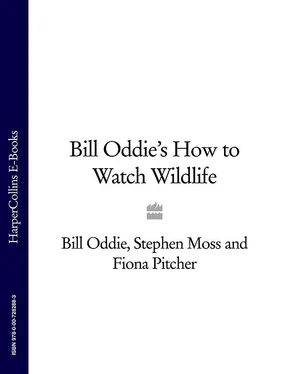One good thing to come out of all those TV gardening shows, though, is the rise of the water feature. Now that is a good thing. Garden ponds are a great way to attract the likes of frogs, toads, newts and the occasional passing heron.
Attracting birds to your garden
You don’t have to transform your garden completely over to the wildlife, but with a few minor adjustments and additions you can turn a bleak desert into a real oasis.
There are plenty of manufacturers vying for your wallet with a huge range of bird feeders, bird-feeding ‘stations’ and numerous types of food available. Start simply and see how you go – one feeder might be quite enough for a small garden or balcony.
Think about where you will hang a birdfeeder or put a bird table. Do you need a stand? Can you hang it from a tree or bush? And, most importantly, work out the best site for them and then supply a variety of foods, ideally at different levels to attract a good range of species.
Here are five excellent ways to attract wildlife to your garden:
_ Put up a bird feeder.
_ Put up a nestbox.
_ Get a bird bath, and keep it filled with clean, fresh water.
_ Plant plenty of native flowers and bushes, which will attract insects and provide seed.
_ Keep a corner that’s a bit scruffy, with rocks and logs where small creatures can hide.
The same applies to putting up a nestbox, but don’t expect instant results. The best time to put one up is before Christmas, and you’re unlikely to see any interest until early spring at least. But by doing so you are providing an opportunity for a pair of birds to bring young into the world – a chance they may have lost without your help.
Another essential is a bird bath as, just like us, birds need water for washing and drinking. Make sure you keep it regularly topped up with clean, fresh water.
Providing food, water and homes for garden birds is, not surprisingly, a growth industry. The cheapest and easiest way to buy products is in bulk through mail order. Check out the various catalogues as many provide useful advice on different products – with top-quality, high-energy foods such as sunflower hearts providing the best all-round meal for birds throughout the year.
Birds may well be the easiest kind of wildlife to watch, but let’s not ignore the other creatures that can come into our gardens. For children, these can be even more of a delight. The truth is that you will be lucky to see a fox or a badger in your garden, even if you are a bit of an insomniac. There are parts of Britain, though, where foxes are very common, especially in urban and suburban areas. Badgers really do only come out at night, or occasionally at dusk, and you’ll need to be close to proper woodland to stand a chance of seeing one of these visitors.
_ Butterflies and other insects love wild flowers – especially native varieties.
_ Butterflies love buddleia, too, also known as the ‘butterfly bush’.
_ Birds love berries, such as holly, ivy and mistletoe.
_ Climbers such as honeysuckle and clematis are ideal places for birds to roost and nest.
Squirrels – well, they are not everyone’s favourite. But surely everyone is entertained by the sight of a squirrel defying all claims that bird feeders are squirrel-proof. Their ingenuity is extraordinary. We have to accept that if we put up bird feeders, with them will come squirrels.
Many of us remember Beatrix Potter’s Mrs Tiggywinkle, and hedgehogs live on as a favourite. But if you do have a visiting hedgehog, put out dog or cat food, as bread soaked in milk will be too filling for it to cope with.
Smaller creatures such as bees, beetles and bugs are often forgotten by us adults – rather unfairly perhaps. Bumblebees are in decline and butterflies, too, need a bit more encouragement, which you can do by planting flowers that attract the bees to collect pollen and feed on nectar.
Water creatures are also fascinating; not only larger ones such as frogs, toads and newts, but also pond insects such as water boatmen and dragonfly larvae. By creating a pond, you will attract all kinds of wild creatures to even the smallest garden, especially if you vary the depth and put in lots of suitable aquatic plants, which will attract other wildlife.
Remember that wildlife ponds are better without ornamental fish as they tend to crowd out any native water creatures. And if you have children under ten, then it can be guaranteed that looking at frogspawn and watching tadpoles will provide hours of fun and an opportunity to learn from nature.
One final thought – make the most of your garden. By taking a bit of effort and providing food, water, shelter and perhaps a garden pond, you’ll make a big difference. It’s the easiest place to enjoy wildlife and, if you’re good to your local wildlife, it will repay you with hours of entertainment.
B CONTENTS INTRODUCTION PART 1 GETTING STARTED WHY WATCH WILDLIFE? WATCHING WILDLIFE IN YOUR GARDEN WILDLIFE BEYOND THE GARDEN GATE KEEPING A RECORD BASIC EQUIPMENT BASIC FIELDCRAFT GETTING HELP FAMILY WILDLIFE WATCHING PART 2 THE WILDLIFE YEAR USING THIS SECTION JANUARY FEBRUARY MARCH APRIL MAY JUNE JULY AUGUST SEPTEMBER OCTOBER NOVEMBER DECEMBER PART 3 BRANCHING OUT ADVANCED EQUIPMENT JOINING UP MAKE SPACE FOR NATURE READING LIST INDEX Bill Oddie’s Acknowledgements Copyright Bill Oddie’s About the Publisher
Wildlife beyond the garden gate
If you’re a city dweller, you may not think there’s much to see where you live. It’s easy to assume you have to travel to the coast or Britain’s deepest countryside for the true wildlife experience. But that is not always the case.
The fact is that modern farming methods, and loss of habitat through development and road building, have hit our countryside wildlife pretty hard. But being adaptable creatures, much of our wildlife has been moving into towns and cities, helped by the ‘wildlife corridors’ such as rivers, railway lines and strips of woodland, which enable them to travel from one place to another.
There are all sorts of advantages to living in towns and cities. For a start they are much warmer than the surrounding countryside, thanks to the waste heat from buildings. There is also far more food: either provided deliberately or by our wasteful habits. That’s why in recent years birds like ‘seagulls’ (or plain ‘gulls’, as they should really be called) have moved into our urban areas, where they feed by scavenging on rubbish tips and roost during the night on reservoirs. They have also started to nest on the roofs of city buildings, where they can be heard even above the noise of the traffic.
So if you’re a townie, rejoice in the fact that British wildlife is making itself seen and heard in cities everywhere. A good place to start is your local park: a green space where the wildlife can find food and shelter. Canals and rivers are also excellent places to look, as are odd sites such as churchyards and cemeteries – anywhere with a small patch of green and some areas of rough vegetation where the creatures can hide. Wildlife watching in cities isn’t always the most scenic of experiences, but it’s certainly full of surprises.
_ Get a friend to take you round their local patch and show you what’s there and what to look out for. Next time, try visiting the place on your own – you’ll be amazed at what you can find. This can be a real boost to your confidence.
Whether you live in the town or the countryside, a suburb or a village, you should be able to find yourself what naturalists call a ‘local patch’ – a place you can visit on a regular basis throughout the seasons to get to know the resident wildlife.
Читать дальше












